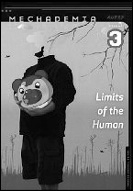Mechademia 3: Limits of the Human
by Jasper Sharp
Flicking through the third volume of Mechademia, it dawned on me I might have been unduly harsh on the direction of this series in my review of the first, Emerging Worlds of Anime and Manga, back in 2006. Though I didn't see the second volume, Networks of Desire, it occurred to me that editor Frenchy Lunning, assisted this time by Thomas Lamarre and Christopher Bolton, is less interested in trying to posit these intrinsically Japanese media in some sort of socio-historical context than in attempting to address them on their own terms.
After all, just as 1965 manga Terebi-Kun ('Television Boy') "plays with the notion of another world that interacts with our everyday existence, while also highlighting the intensely commercial nature of the medium", as Michael Dylan Foster explains in one of the earlier essays, 'The Otherworlds of Shigeru Mizuki', the post-modern floating worlds created on the page or on the screen (with the emphasis on 'created', not 'recorded' or 'reproduced') with which Mechademia engages are more about imagination than reality. In this context, the way these images become dis-anchored from their cultural roots and reach audiences across the world is of interest.
Foster's essay won me round, of course, as I've been a huge fan of Mizuki's Ge Ge Ge no Kitaro manga for some time, with its panoply of yokai - spirits and mystical beings drawn from legend and tradition. (In fact, isn't it about high time someone thought of publishing English translations of this beautifully grotesque series? As an aside, I have this hazy, near subliminal, memory from my distant childhood of seeing an animated 'kassa-obake', or umbrella ghost, on UK television in the early 1970s - but I can't think what this would have been, or why it would have been broadcast. Anyone with any ideas out there?). Foster provides a beautiful balance between factual information and theory in his exploration of the origins of Mizuki's fantastical and eccentric creatures, and why they constitute such a strong "postwar construction of a communal memory of a premodern cultural ecology".
The themes addressed in Limits of the Human are wide-ranging, and are divided into three sections: Contours - Around the Human, Companions - With the Human, and Compossibles - Of the Human. Sure enough, the Ghost in the Shell films come up for discussion, notably in Steven T. Brown's fascinating 'Machinic Desires: Hans' Bellmer's Dolls and the Technological Uncanny in Ghost in the Shell 2: Innocence' and Sharalyn Orbaugh's 'Emotional Infectivity: Cyborg Affect and the Limits of the Human', both of which isolate specific strands from the wide range of influences Oshii has drawn upon in his film (I must say, I never knew anything about Auguste Villiers de l'Isle-Adam's 1886 novel L'Eve Future, with its perfect artificial woman called Hadaly, that Orbaugh writes about).
Other topics under discussion include Theresa Whinge's "Undressing and Dressing Loli: A Search for the Identity of the Japanese Lolita", Thomas Lamarre's "Speciesism, Part 1: Translating Races into Animals in Wartime Animation" and Takayuki Tatsumi's "Gundam and the Future of Japanese Art." While I'm not going to renege on my original assessment of the first Mechademia, as some of its essays were distinctly sub-par, this third volume shows the journal clearly establishing a serious identity of its own and as such provides a vital platform for intelligent discussions of anime and manga. I look forward to the next.
